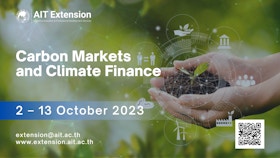
In the last decade, carbon market and carbon finance have emerged as a means to shoulder the costs of mitigation and adaptation. Several carbon markets and carbon finance schemes have been set up and are functioning at various levels. By 2018, 51 carbon pricing initiatives have been implemented.
This includes 25 Emission Trading Systems, 26 Carbon Taxes and cover 11 GtCO2e, or 20 per cent of global GHG emissions representing total value of ETS and Tax as US$82 billion. In South East Asia, Singapore became the first country to price carbon with 5 S$ per tCO2e. Article 6.2 of Paris Agreement, which has provision of ITMO (Internationally Transferrable Mitigation Outcome), is under negotiation.
In 2017, over 1,300 companies—including more than 100 Fortune Global 500 companies with collective annual revenues of about US$7 trillion—disclosed to CDP that they are using an internal price on carbon to inform their decision making, or plan to do so in the next two years, which is an increase of 11 percent compared to 2016.
Global climate finance stands about 400 billion US$ while about 50 billion are coming from developed to developing countries. Under UNFCCC negotiations, 100 billion US$ per year are under horizon from developed to developing countries.
These carbon markets and finances are different from other conventional markets and finances due to its own context, operating environment, principle and modus operandi. These markets and finances are expected to grow in the next decade.
Course objectives:
The objective of this course is to provide a solid foundation on carbon market and carbon finance from a multiple perspective.
Course outline:
- Global climate change, UN processes and emergence of carbon market and climate finance
- Type, nature and diversity of carbon markets
- Compliance carbon markets: Experiences, design features, trends and outcomes (Emission trading and carbon tax)
- Voluntary (unregulated) carbon markets, including internal carbon pricing in corporate sector
- Emerging carbon markets issue and opportunities, such as bilateral market, Paris Agreement Article 6.2, ICAO, IMO, REDD+
- Climate investment needs assessment
- Global architecture of climate finance (public, private, funding sources, mechanism beneficiaries, sectors, financial instruments, key institutions)
- Climate financing mechanisms at national scales.
- Future outlook
Publish your content with EB Publishing
It's about who you reach. Get your news, events, jobs and thought leadership seen by those who matter to you.




